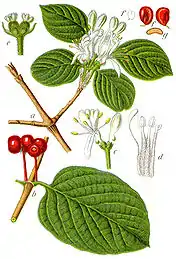Lonicera xylosteum
Lonicera xylosteum, commonly known as fly honeysuckle,[1] European fly honeysuckle, dwarf honeysuckle[2] or fly woodbine is a deciduous shrub.[1]
| Lonicera xylosteum | |
|---|---|
 | |
| Scientific classification | |
| Kingdom: | Plantae |
| Clade: | Tracheophytes |
| Clade: | Angiosperms |
| Clade: | Eudicots |
| Clade: | Asterids |
| Order: | Dipsacales |
| Family: | Caprifoliaceae |
| Genus: | Lonicera |
| Species: | L. xylosteum |
| Binomial name | |
| Lonicera xylosteum | |

Lonicera xylosteum
The glossy red (or occasionally yellow) berries of this shrub are mildly poisonous to humans – children who ingest a large number (c. 30) of berries may experience abdominal pain and vomiting.[3]
References
- "Fly honeysuckle". RHS Gardening. Royal Horticultural Society. Retrieved 31 August 2017.
- "Plants profile for Lonicera xylosteum". Plants database. Natural Resources Conservation Service. Retrieved 31 August 2017.
- "Lonicera xylosteum". Canadian Poisonous Plants Information System. Canadian Biodiversity Information Facility. Retrieved 31 August 2017.
This article is issued from Wikipedia. The text is licensed under Creative Commons - Attribution - Sharealike. Additional terms may apply for the media files.